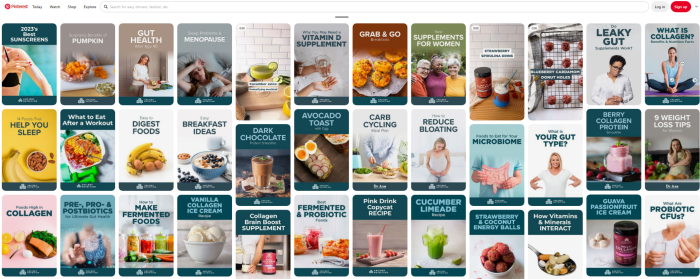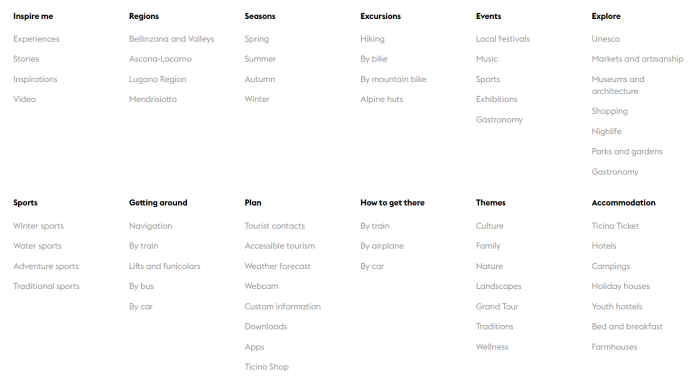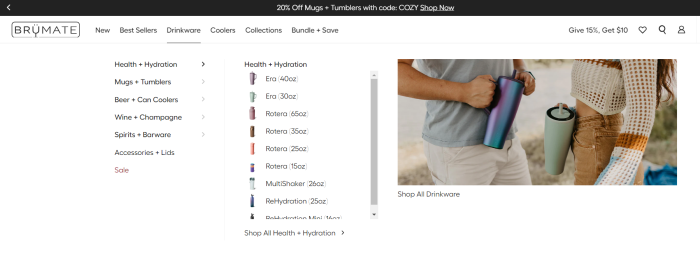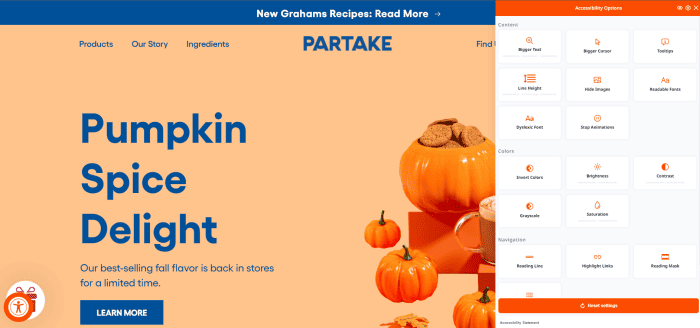First impressions are everything – especially in the digital age with a world’s worth of information at your fingertips. In fact, research suggests that 94% of first impressions about a website relate to its design. Today’s consumers are smarter, savvier and more selective than ever, and if your business’ website fails to capture their attention, you’ll risk losing potential customers before they can explore what you have to offer. Fortunately, 2024 web design trends offer a silver lining. These cutting-edge approaches to web design ensure that your website not only survives, but thrives in an increasingly competitive online landscape. With the new year quickly approaching, let’s explore the top web design trends of 2024 and how they can help your business make a lasting impression and generate brand loyalty:
1. Interactive Elements
Interactive elements are poised to take center stage in web design for 2024. From captivating hover effects that respond to user actions to gamified interfaces that encourage user participation, websites are an immersive playground where users are active participants in the digital journey. These interactive features go beyond mere aesthetics – they enhance functionality and usability, making it easier for users to navigate and interact with their website content seamlessly.
Whether it’s dynamic product showcases, interactive storytelling or immersive data visualizations, interactive elements push the boundaries of creativity and user retention and conversion rates. As we head into 2024, forward-thinking web designers will need to recognize that interactive elements are the key to holding their audience’s attention in the modern-day digital landscape.
Utilizing Interactive Elements in Your 2024 Web Design Strategy
Infographics: Instead of static infographics, companies can create interactive data visualizations. Users can hover over data points, click for more details and even manipulate data sets to gain a deeper understanding of complex information.
Virtual Try-Ons: Retailers selling clothing, accessories or cosmetics can implement virtual try-on experiences. Users can upload their photos or use their device’s camera to see how products look on them before making a buying decision. This helps to decrease uncertainty and increase the likelihood of converting.
Location-Based Features: Companies can integrate maps with interactive features, allowing users to explore physical locations, find nearby stores or events and get directions. This is particularly useful for businesses with multiple physical locations.
Quizzes and Assessments: Businesses can build interactive quizzes and assessments that provide personalized recommendations or insights based on user input to create a valuable and engaging experience. Companies can also gather user feedback and opinions through interactive polls and surveys so their customers feel that their input matters.
By incorporating these interactive elements into their web design strategies for 2024, businesses can create more engaging, user-centric and memorable online experiences that ultimately drive customer satisfaction and conversions.
Interactive Elements Done Right: Redwood Empire Whiskey
Redwood Empire Whiskey doesn’t just encourage users to interact with their website – they make it a mandatory aspect of their user experience. Before users can even enter their website, they must first click and drag to “plant” a seed. This then brings them to a landing page detailing Redwood Empire’s partnership with Trees For The Future which plants a tree for every bottle sold, in addition to their company history and product information. Not only does this make for a memorable browsing experience, but it also makes potential customers feel good about purchasing their products with the knowledge that it will benefit the environment.
2. Storytelling
Websites are no longer static information repositories – they are immersive digital narratives that can be powerful tools for captivating and connecting with users on a profound level. In the fast-paced digital landscape, storytelling offers a powerful means to engage visitors, convey brand identity and establish an emotional connection. Whether it’s through compelling visuals, multimedia elements or interactive narratives, the businesses that succeed in 2024 and beyond are those that are able to convey a well-crafted story throughout their website design – one that drives user engagement and leaves a lasting impression.
As we head into the new year, we can expect to see more and more brands weaving their unique stories into the fabric of their websites, sharing their history, values and missions in a more human and relatable manner. Storytelling also serves as a valuable tool for guiding users through complex processes, simplifying information and making data more accessible and digestible. In 2024, web design trends aren’t just about aesthetics and functionality – they’re about creating an emotional journey that resonates with users, fosters brand loyalty and sets businesses apart in a crowded online landscape.
Utilizing Storytelling in Your 2024 Web Design Strategy
Origin Stories: Share the company’s history, founders’ journey and the values that inspired its creation. This humanizes the brand and creates a connection with users who can connect with the company’s heritage.
Customer Success Stories: Showcase real-life customer stories and testimonials. Highlighting how your products or services have positively impacted individuals or businesses builds trust and credibility.
Interactive Brand Journeys: Create interactive timelines or scrolling experiences that take users on a visual journey through the brand’s evolution, milestones and achievements. This approach keeps users engaged and informed.
Video and Animation: Use video and animation to tell compelling stories. Whether it’s an animated explainer video, a behind-the-scenes look at your company or customer interviews, multimedia can be a powerful storytelling tool when integrated into your website’s design.
Storytelling is a powerful web design tool that goes beyond aesthetics. When used strategically, it forges emotional connections, engages users deeply, and conveys the essence of a brand or message with authenticity and impact.
Storytelling Done Right: Allens
Australia’s oldest law firm, Allens, used storytelling web design to celebrate their milestone 200th anniversary in a big way. Website visitors can scroll down this landing page to learn all about their company history from 1816 to now. This immersive storytelling approach not only honors their rich legacy but also effectively connects with visitors, fostering a sense of trust, transparency and authenticity. By allowing users to explore their history at their own pace, Allens showcases how effective storytelling in web design can both commemorate a significant milestone and build a deeper connection with their audience.
3. AI & Machine Learning
Artificial intelligence (AI) and machine learning are poised to revolutionize web design in 2024and usher in a new era of intelligent, personalized online experiences. These technologies empower businesses to understand their users on a deeper level by analyzing data, predicting behavior and delivering tailored content in real time. Machine learning algorithms can adapt to user preferences, making websites more intuitive and user-centric to ultimately improve engagement and conversion rates. From chatbots that provide instant customer support to recommendation engines that suggest products or content, AI-driven elements are becoming integral to ensuring that each website user’s journey is unique and optimized.
Additionally, AI and machine learning enhance website performance and security. They can detect and respond to security threats, which provides an additional layer of protection against cyberattacks. These technologies enable advanced data analytics that can help businesses gain valuable insights into user behaviors, demographics and trends that can inform future design decisions and marketing strategies. As AI and machine learning continue to evolve, web designers in 2024 will need to leverage their capabilities to create smarter and more adaptive online experiences that not only meet but exceed user expectations.
Utilizing AI & Machine Learning in Your 2024 Web Design Strategy
Content Recommendations: Implement recommendation engines that analyze user behavior and preferences to suggest relevant products, articles or content. This keeps users engaged and increases the chances of conversion.
Predictive Analytics: Use predictive analytics to anticipate user needs before time or supply is an issue. For example, an e-commerce site can predict when a customer is likely to run out of a consumable product and offer a convenient reorder option.
Chatbots and Virtual Assistants: Utilize AI-powered chatbots and virtual assistants to provide instant customer support, answer common queries and guide users through your website in a conversational manner.
User Behavior Analysis: Use machine learning to analyze user behavior and identify patterns or trends in your industry. This can inform design decisions, content creation and marketing strategies moving forward.
By incorporating AI and machine learning into their web design strategies, businesses can create more intelligent, user-focused and efficient websites that adapt to user needs and provide a seamless online experience in the year ahead. These technologies are becoming invaluable tools for staying competitive and relevant in the digital landscape of 2024.
AI & Machine Learning Done Right: Pinterest
Pinterest leverages AI and machine learning technologies to curate personalized feeds for its users. Through a combination of advanced algorithms, data analysis and user behavior tracking, Pinterest tailors content recommendations to each individual’s preferences and interests. By analyzing what users have pinned, liked or engaged with in the past, Pinterest’s AI systems can predict and suggest content that aligns with a user’s tastes. Pinterest’s use of AI and machine learning demonstrates how technology can transform the user experience by delivering content that feels tailor-made, ultimately making it a valuable platform for discovery and inspiration.
4. Personalization
In an era where consumers expect tailored experiences, personalization leverages data and technology to create highly individualized website journeys. With this in mind, it’s no surprise that personalization will continue to be a central web design trend as we head into 2024. From product recommendations to adaptive user interfaces, personalization enhances user engagement, satisfaction and conversion rates. Businesses are recognizing that one-size-fits-all approaches are no longer sufficient in a competitive digital landscape, and they are embracing personalization to provide more relevant and meaningful experiences to their website visitors.
In 2024, successful web design is not just about creating visually appealing sites – it’s about creating user-centric, tailored experiences that foster a connection with a brand and offer control over how they consume media. As businesses continue to invest in personalization, we can expect that the most successful websites will be the ones that adapt and evolve to deliver content and experiences that resonate with each unique visitor.
Utilizing Personalization in Your 2024 Web Design Strategy
Personalized Product Recommendations: Implement algorithms that analyze user behavior, purchase history and preferences to suggest products or services that are highly relevant to each visitor. This encourages users to explore more offerings and increases the likelihood of conversions.
Adaptive User Interfaces: Create user interfaces that adapt to individual preferences, such as font size, color schemes and layout. This helps to enhance accessibility and usability for the widest array of diverse user needs and abilities.
Content Filtering and Sorting: Implement advanced filtering and sorting options for content-heavy websites, allowing users to personalize their browsing experience by narrowing down content based on their interests and criteria.
Personalized Landing Pages: Craft landing pages that dynamically change based on the source of traffic or the user’s past interactions with your website to deliver a more targeted message.
Integrating personalization into their web design strategies enables businesses to create more engaging and user-centric websites that cater to individual needs and preferences. This not only improves user satisfaction but also drives higher conversion rates and fosters long-term customer loyalty in the digital landscape of 2024 and beyond.
Personalization Done Right: Ticino
Planning a vacation requires a personalized touch, and Ticino’s website has taken this concept to heart to encourage tourism in their region. Their website serves as a dynamic gateway for travelers by offering a menu rich in customization options. Visitors can tailor their experience by selecting specific regions, seasons, excursions and even indicating how they intend to get around. This level of personalization ensures that every traveler’s unique preferences and interests are catered to as they navigate the website and plan their vacation. By allowing visitors to craft their ideal Ticino experience, the website entices tourism and showcases the region’s commitment to providing an unforgettable adventure for each and every unique traveler.
5. User Experience (UX) Design
User Experience (UX) design isn’t new to the web design sphere, but it will be one of the most important web design trends as we approach 2024. In an era where user satisfaction and ease of navigation are necessary for success in the digital domain, businesses are placing an even greater emphasis on creating seamless and intuitive online experiences. UX design transcends aesthetics – it revolves around comprehending user behaviors, needs and motivations to craft websites that are not only visually appealing but also highly functional.
Today’s web designers must embrace a user-centric approach and rely on extensive research, user testing and data analysis to steer their design decisions. Businesses are not just meeting user expectations by prioritizing UX design in their web design strategy – they are also setting themselves apart in the competitive online landscape to ultimately enhance their brand reputation and customer satisfaction.
Utilizing UX Design in Your 2024 Web Design Strategy
Performance Optimization: Ensure fast page loading times, minimize loading screens and optimize images and content to prevent user frustration due to slow load times.
Streamlined Forms: Simplify forms and minimize the number of required fields to reduce friction during user interactions, particularly for sign-ups and checkouts.
Search Functionality: Implement an efficient on-site search feature with auto-suggestions and filters to help users quickly find what they’re looking for.
Progress Indicators: Display progress bars or indicators during multi-step processes, such as checkout or form submissions, to keep users informed and reduce uncertainty.
By integrating these UX design principles and practices into their web design strategies for 2024, businesses can create user-centric websites that prioritize user satisfaction, boost engagement and drive conversions to ultimately leading to long-term success in the digital realm.
UX Design Done Right: Brumate
Drinkware company Brumate’s website sets a high standard with its sleek and user-centric UX design. It boasts a clean and intuitive layout that makes navigating their product lineup an absolute breeze, thanks in part to their mega menu, which ensures you can find precisely what you’re looking for without having to search far for it. Their carefully chosen featured images showcase their drinkware collection and capture the essence of their brand to provide a visually impactful experience. Brumate further exemplifies their strategic prowess by seamlessly integrating social media elements, creating a dynamic web platform that enhances user engagement and fosters meaningful brand interaction.
6. Nostalgia
There has been a noticeable resurgence in music, film and fashion from previous decades, and this nostalgic wave sweeping across popular culture has also paved the way for a reimagining of design trends. Given this cultural backdrop, it makes perfect sense that website design, too, is embracing the allure of nostalgia in 2024. From the vibrant and playful designs of Y2K to the simplicity and minimalism of mid-century modern design, web designers are recognizing that harnessing the power of the past can create a unique and resonant user experience.
This trend extends beyond mere aesthetics – it’s about crafting web experiences that trigger a sense of familiarity and comfort while seamlessly integrating modern functionalities. Businesses are increasingly infusing elements of bygone decades onto their websites, such as retro color palettes, vintage typography and even retro-inspired user interfaces. In essence, nostalgia in web design for 2024 represents a deliberate blend of the old and the new, showcasing how the past can be reimagined to create fresh, captivating and memorable digital experiences. It’s important to note that this trend is often best used sparingly, such as a specific landing page or themed interactive content – don’t let the wave of nostalgia overpower your branding!
Utilizing Nostalgia in Your 2024 Web Design Strategy
Interactive Timelines: Use interactive timelines to showcase the history and evolution of the brand to immerse your website visitors in a nostalgic journey through time.
Retro User Interfaces: Design user interfaces that mimic the look and feel of technology from the past, such as retro-inspired buttons, sliders and interactive content.
Old-School Graphics: Incorporate design elements like pixel art, retro patterns or vintage illustrations to give the website a sense of nostalgia and familiarity.
Vintage Typography: Use typography styles that were popular in past eras, like retro fonts from the 1950s or the quirky, pixelated text reminiscent of 8-bit video games from the 1980s.
By infusing these nostalgic elements into their web design strategies, businesses can create a unique and emotionally resonant online presence that connects with users on a personal level and adds a fun and unexpected element to your design.
Nostalgia Done Right: Old Iron Press
Physical books (remember those?) may seem like relics of the past, and publishing company Old Iron Press leans into this nostalgia with a website design that transports visitors back to the 1970s. Their choice of fonts and a color palette reminiscent of that era evokes a sense of retro charm, as if you’ve stepped into a vintage bookstore with well-worn paperbacks and the hum of a vinyl record playing in the background. This retro-inspired design pays homage to a classic era of print and adds a unique character to their online presence that makes their brand unique and memorable.
7. Microinteractions
Microinteractions emerged as one of the most prominent web design trends in recent years, and this will continue heading into 2024. As the name suggests, microinteractions are small interactive design elements that engage users by responding to their actions in real-time, making websites more dynamic and intuitive. Microinteractions can take various forms, such as animated buttons, progress bars and haptic feedback that provides users with instant visual or tactile cues that guide them through their digital journey.
Incorporating microinteractions into web design is all about enhancing usability and creating a sense of responsiveness. Whether it’s a subtle hover effect that indicates a clickable element or a subtle change that acknowledges a successful action (like a heart graphic filling in red when users “like” a post), these design elements go a long way in making users feel more engaged and in control of their online experience.
Utilizing Microinteractions in Your 2024 Web Design Strategy
Scroll-Triggered Effects: Create microinteractions triggered by scrolling, such as parallax scrolling, fading elements in or out, or revealing content as users navigate down the page.
Progress Indicators: Display subtle progress bars or animations when users upload files, complete a multi-step process, or download content to keep them informed and engaged.
Menu Animations: Add subtle animations to navigation menus, such as dropdown menus that smoothly expand and collapse or icons that transform when clicked.
Hover Effects: Employ hover effects for images or links, like enlarging thumbnails or displaying additional information when users hover over a product image or link.
These subtle design elements not only make the user experience more enjoyable, but also contribute to higher user satisfaction and increased interaction with a website’s features and content.
Microinteractions Done Right: Buddha Pizza
Your eyes aren’t deceiving you – the pizza’s eyes are following you around Buddha Pizza’s landing page! As you move your cursor across the screen, the animated pizza character’s eyes playfully track its movement, creating an engaging and playful user experience. This microanimation not only captures visitors’ attention, but also infuses the Buddha Pizza’s digital presence with a sense of personality and humor.
8. Voice User Interface (VUI)
Voice User Interface (VUI) is poised to be one of the most critical web design trends for 2024, as it reshapes the way users interact with websites on a day-to-day basis. With the widespread adoption of voice-activated devices like smart speakers and virtual assistants, users are increasingly turning to voice commands to navigate the digital world. VUIs enable websites to accommodate this shift by allowing users to interact with the content and functionality using natural language.
Web designers in 2024 will need to to this trend by integrating voice search, voice commands and conversational interfaces into their web design strategies. This means optimizing websites for voice queries, providing spoken responses and even offering voice-guided navigation. VUIs also have the potential to enhance accessibility for users with disabilities, providing an inclusive online experience. As VUI continues to gain prominence in 2024, websites that embrace this technology are poised to offer more versatile, user-friendly and engaging interactions, thus setting the stage for the future of digital design and user interface.
Utilizing Voice User Interfaces in Your 2024 Web Design Strategy
Voice Search Integration: Implement voice search functionality on your website, allowing users to find products, information, or specific content simply by speaking their queries.
Voice-Activated Commands: Enable users to perform actions on your website, such as adding items to a cart, checking out or subscribing to newsletters, using voice commands.
Voice-Controlled Forms: Implement voice-activated form filling, where users can verbally input information into fields, streamlining processes like registrations and surveys.
Multilingual Support: Offer VUIs in multiple languages to cater to a diverse user base and expand your reach to international audiences.
By integrating these VUI features into their web design strategies, businesses can create more user-friendly and accessible websites that cater to the growing trend of voice interaction.
VUI Done Right: Speechly
Not only does Speechly utilize VUI on their own website, they also enable other businesses to utilize it on theirs. By providing companies with the technology and expertise to integrate VUI into their applications and platforms, Speechly empowers businesses to create highly responsive and user-friendly voice-enabled experiences for their own customers. Whether it’s enabling voice chat moderation or real-time transcription, Speechly’s VUI solutions open up a world of possibilities for businesses looking to stay at the forefront of voice technology and offer more efficient interactions with their audience.
9. Accessibility-Focused Design
Speaking of accessibility, this web design trend is more of a web design must-have. Accessibility ensures that websites can be used by individuals of all abilities, including those with disabilities such as visual impairments, hearing impairments or motor disabilities. Web designers in 2024 and beyond will need to focus on creating inclusive digital experiences by adhering to accessibility guidelines and standards, such as the Web Content Accessibility Guidelines (WCAG), to make their websites perceivable, operable and understandable for everyone.
To meet accessibility standards, web designers must conduct comprehensive accessibility audits, considering factors like color contrast, font choices and assistive technology compatibility. They’ll also need to focus on accessible multimedia content, like providing transcripts for videos and captions for audio content. Some businesses are even actively involving users with disabilities in the testing and feedback process to ensure that their websites provide a seamless experience for users of all abilities. In 2024, accessibility will be a fundamental pillar of web design that reflects a business’ commitment to making the digital world more equitable and user-friendly.
Utilizing Accessibility-Focused Design in Your 2024 Web Design Strategy
Alt Text for Images: Provide descriptive alt text for all images, ensuring that users with visual impairments can understand the content and context of the images.
Contrast and Color Choices: Pay attention to color contrast to make text and content readable for users with low vision. Avoid relying solely on color to convey information.
Video Accessibility: Provide closed captions, transcripts and audio descriptions for videos to make multimedia content accessible to users who are deaf or hard of hearing or those who cannot view the video.
Keyboard Navigation: Ensure that all interactive elements such as buttons and forms are easily navigable and usable with a keyboard alone, without requiring a mouse.
Accessible web design is an essential aspect of responsible web design that ensures equal access and usability for all users. Integrating these accessibility features and principles into their web design strategies helps businesses create digital spaces that are truly inclusive and accommodating to users of all abilities.
Accessible Web Design Done Right: Partake Foods
Allergy-friendly food brand Partake Foods has made their commitment to accessible browsing a key feature of their web design. As soon as a user lands on their homepage, they are presented with the ability to activate a range of accessibility features, including larger text, inverted colors and larger fonts, among others. This thoughtful approach not only showcases their dedication to inclusivity but also empowers users to customize their browsing experience according to their specific needs and preferences. This is a noteworthy example of how web accessibility should be seamlessly integrated into the digital landscape, and will continue to do so heading into 2024.
10. Minimalism
With so many design elements and digital distractions competing for a website user’s attention, sometimes simplicity reigns supreme. That’s why minimalism will continue to be a timeless and influential web design trend for 2024. This design style champions simplicity, emphasizing clean layouts, ample white space, and a focus on essential content and functionality. In an age where information overload is common, minimalism offers a breath of fresh air that reads well and functions optimally on any screen size.
Incorporating minimalism into web design involves sleek and uncluttered interfaces, simplified navigation menus and the use of high-quality, captivating visuals to convey the brand’s message succinctly. Minimalist websites are characterized by their efficient use of space, precise typography and a restricted color palette. This approach helps to enhance user engagement and readability while also contributing to faster loading times and better mobile responsiveness. In 2024, minimalism remains a prevailing web design trend that reflects the desire for elegance, functionality and user-centered simplicity in the digital realm.
Utilizing Minimalism in Your 2024 Web Design Strategy
Clean Layouts: Embrace clean and uncluttered layouts that prioritize essential content and minimize distractions, ensuring a clear and focused user experience.
Simplified Navigation: Streamline navigation menus to feature only the most important sections or categories, making it easier for users to find what they’re looking for quickly.
White Space: Use white space generously to create visual breathing room, separating content elements and improving readability while adding an elegant touch to the design.
Limited Color Palette: Opt for a restrained color palette with a few carefully selected hues that align with your brand identity, creating a cohesive and visually pleasing aesthetic.
Minimalism is ideal for simplifying the user experience in a way that communicates professionalism and clarity. By incorporating these minimalistic design elements and principles into their web design strategies, businesses can create elegant, user-focused and visually appealing websites that prioritize content and functionality.
Minimalism Done Right: ETQ
As they say on their landing page, menswear brand ETQ keeps luxury simple. Their website embodies the principles of minimalism, where less truly means more. The clean and uncluttered layout allows their products to take center stage without distractions to ensure an easy browsing experience across devices. The neutral color palette, precise typography and strategic use of negative space evoke a sense of elegance and sophistication that reflects their branding. ETQ understands that in a world of visual noise, simplicity can be a statement in itself.
Ready to Design Your 2024 Digital Marketing Strategy?
If this list is any indication, there are a ton of exciting changes and trends on the horizon of the web design world. From new technologies to emerging design styles, there are plenty of new and innovative ways to create a website that’s both informative and engaging in the year to come. Of course, the most important part of any web design project is understanding the needs and wants of your target audience. By keeping your finger on the pulse of the latest trends and technologies, you can ensure that your website is always ahead of the curve and providing your visitors with the best possible experience.
Ready to start planning and implementing your 2024 website design strategy? Creative Click Media’s team of expert web designers can help you create a website that’s both beautiful and functional. Your winning new website is only a click away – contact us to get started














